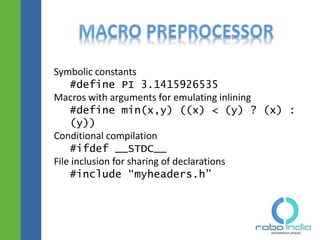The document provides an overview of the C programming language, detailing its history, structure, and functionality including data types, operators, loops, functions, arrays, strings, structures, and unions. It explains key concepts such as variable declaration, pointer usage, and modular programming through functions, as well as the importance of header files and preprocessor directives. Additionally, it covers basic syntax and examples for performing operations in C, emphasizing its applicability in systems programming.











![• arithmetic: + – * / %
• comparison: == != < <= > >=
• bitwise logical: & | ^ ~
• shifting: << >>
• lazy logical: && || !
• conditional: ? :
• assignment: = += -=
• increment/decrement: ++ --
• sequencing: ,
• pointer: * -> & []](https://image.slidesharecdn.com/clanguage-150311082321-conversion-gate01/85/C-language-12-320.jpg)










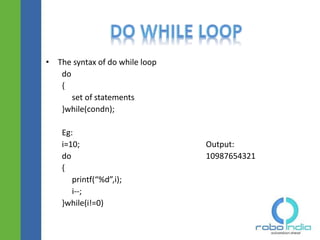

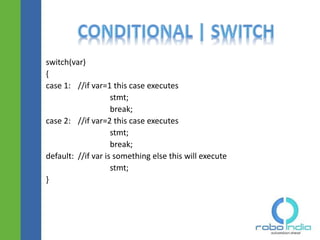




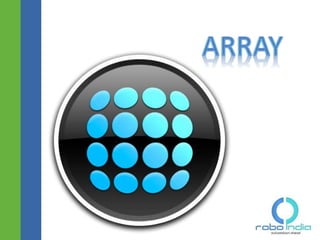
![• Array
– Group of consecutive memory locations
– Same name and type
• To refer to an element, specify
– Array name
– Position number
• Format:
arrayname[ position number ]
– First element at position 0
– n element array named c:
• c[ 0 ], c[ 1 ]...c[ n – 1 ]](https://image.slidesharecdn.com/clanguage-150311082321-conversion-gate01/85/C-language-31-320.jpg)
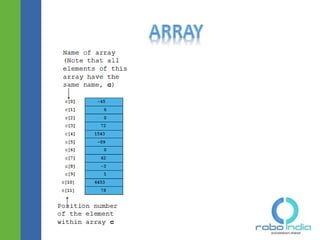
![• When declaring arrays, specify
– Name
– Type of array
– Number of elements
arrayType arrayName[ numberOfElements ];
– Examples:
int c[ 10 ];
float myArray[ 3284 ];
• Declaring multiple arrays of same type
– Format similar to regular variables
– Example:
int b[ 100 ], x[ 27 ];](https://image.slidesharecdn.com/clanguage-150311082321-conversion-gate01/85/C-language-33-320.jpg)
![• Initializers
int n[ 5 ] = { 1, 2, 3, 4, 5 };
– If not enough initializers, rightmost elements
become 0
int n[ 5 ] = { 0 }
• All elements 0
– If too many a syntax error is produced syntax error
– C arrays have no bounds checking
• If size omitted, initializers determine it
int n[ ] = { 1, 2, 3, 4, 5 };
– 5 initializers, therefore 5 element array](https://image.slidesharecdn.com/clanguage-150311082321-conversion-gate01/85/C-language-34-320.jpg)
![• Initialization
– int b[ 2 ][ 2 ] = { { 1, 2 }, { 3, 4 } };
– Initializers grouped by row in braces
– If not enough, unspecified elements set to zero
int b[ 2 ][ 2 ] = { { 1 }, { 3, 4 } };
• Referencing elements
– Specify row, then column
printf( "%d", b[ 0 ][ 1 ] );
1 2
3 4
1 0
3 4](https://image.slidesharecdn.com/clanguage-150311082321-conversion-gate01/85/C-language-35-320.jpg)
![So far we have used one-dimensional (1D) arrays,
but we can also use arrays with 2 or more
dimensions. 2D arrays essentially correspond to
matrices.
Example:
• int A; // single variable
• int B[6]; // 1D array
• int C[3][4]; // 2D array (matrix)
• int D[3][4][5]; // 3D array
• int E[3][4][5][3]; // 4D array
• //etc](https://image.slidesharecdn.com/clanguage-150311082321-conversion-gate01/85/C-language-36-320.jpg)




![• Allocate an array of a size large enough to hold the
string (plus 1 extra value for the delimiter)
• Examples (with initialization):
char str1[6] = “Hello”;
char str2[] = “Hello”;
char *str3 = “Hello”;
char str4[6] = {‘H’,’e’,’l’,’l’,’o’,’0’};](https://image.slidesharecdn.com/clanguage-150311082321-conversion-gate01/85/C-language-41-320.jpg)

















![• typedef struct student
• {
• int id;
• Char name[10];
• }s;
• Now I can put
• s s1,s2;](https://image.slidesharecdn.com/clanguage-150311082321-conversion-gate01/85/C-language-59-320.jpg)


